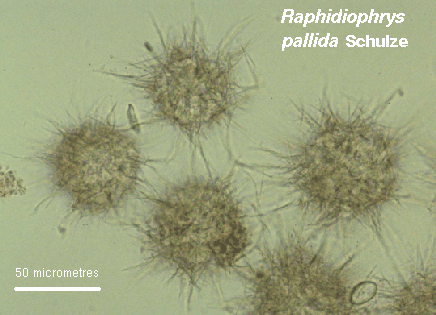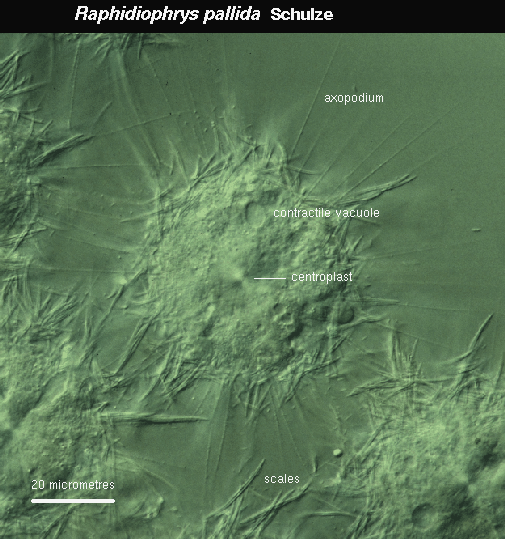Raphidiophrys
Appearance
Raphidiophrys cells usually are encountered as rounded,
axopodial amoebae, either
suspended in the water column or loosely adhering to substrate. In most
species, the cells are
solitary, but in a few the cells may form loose, unorganized colonial
aggregates.
 The trophic cells range from 10 to 150 micrometers in length; individual
species have
characteristic size ranges within these limits. No flagella are present.
The cells appear coarsely
"furry" due to a covering of flattened silica scales. The scales may
adhere to each other, to the
cell body (which may have a gelatinous coat around it), and to the
axopodia radiating from the
cell body; but they do not project at right angles to the cell surface.
Depending on the species,
the scales may be circular, ellipsoidal or nearly linear.
The trophic cells range from 10 to 150 micrometers in length; individual
species have
characteristic size ranges within these limits. No flagella are present.
The cells appear coarsely
"furry" due to a covering of flattened silica scales. The scales may
adhere to each other, to the
cell body (which may have a gelatinous coat around it), and to the
axopodia radiating from the
cell body; but they do not project at right angles to the cell surface.
Depending on the species,
the scales may be circular, ellipsoidal or nearly linear. |
 Axopodia, unlile the scales, radiate from the cell body at right angles to
the cell surface. They
are longer and much more slender than the scales and may bear prominent
beads ("kinetocysts",
a structurally distinct type of extrusome). Axopodia are used to capture
prey and to move cells
along a substrate. Disturbed cells may retract the axopodia.
Axopodia, unlile the scales, radiate from the cell body at right angles to
the cell surface. They
are longer and much more slender than the scales and may bear prominent
beads ("kinetocysts",
a structurally distinct type of extrusome). Axopodia are used to capture
prey and to move cells
along a substrate. Disturbed cells may retract the axopodia.
The
axopodia radiate from a prominent body, the centroplast, located in
the geometric center of
the cell. Both the centroplast and the axopodial microtubules radiating
from it are strongly
birefringent, easily visible in plane-polarized light and optical systems
(such as differential
interference contrast = Nomarski optics) based on plane-polarized
light. |
The single nucleus is eccentrically located. Most other organelles are
located in the peripheral cytoplasm; these organelles typically include
one or more contractile vacuoles. In several
species, the peripheral cytoplasm may harbor endosymbiotic coccoidal green
algae ("zoochlorellae"); the species illustrated here was named
pallida ("pale", "pallid") precisely because zoochlorellae are
absent, and this lack was considered unusual at the time the species was
described.
The centrally-located, birefringent centroplast separates centrohelid
heliozoa from other radially-symmetrical, axopodial amoebae. The absence
of "spine" scales projecting at right angles from
the cell surface separates Raphidiophrys from other centrohelids.
Return to summary information
 The trophic cells range from 10 to 150 micrometers in length; individual
species have
characteristic size ranges within these limits. No flagella are present.
The cells appear coarsely
"furry" due to a covering of flattened silica scales. The scales may
adhere to each other, to the
cell body (which may have a gelatinous coat around it), and to the
axopodia radiating from the
cell body; but they do not project at right angles to the cell surface.
Depending on the species,
the scales may be circular, ellipsoidal or nearly linear.
The trophic cells range from 10 to 150 micrometers in length; individual
species have
characteristic size ranges within these limits. No flagella are present.
The cells appear coarsely
"furry" due to a covering of flattened silica scales. The scales may
adhere to each other, to the
cell body (which may have a gelatinous coat around it), and to the
axopodia radiating from the
cell body; but they do not project at right angles to the cell surface.
Depending on the species,
the scales may be circular, ellipsoidal or nearly linear. Axopodia, unlile the scales, radiate from the cell body at right angles to
the cell surface. They
are longer and much more slender than the scales and may bear prominent
beads ("kinetocysts",
a structurally distinct type of extrusome). Axopodia are used to capture
prey and to move cells
along a substrate. Disturbed cells may retract the axopodia.
Axopodia, unlile the scales, radiate from the cell body at right angles to
the cell surface. They
are longer and much more slender than the scales and may bear prominent
beads ("kinetocysts",
a structurally distinct type of extrusome). Axopodia are used to capture
prey and to move cells
along a substrate. Disturbed cells may retract the axopodia.